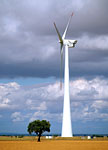How Do Wind Turbines Work?

This aerial view of a wind turbine plant shows how a group of wind turbines can make electricity for the utility grid. The electricity is sent through transmission and distribution lines to homes, businesses, schools, and so on. View the wind turbine animation to see how a wind turbine works or take a look inside.
Wind is a form of solar energy and is a result of the uneven heating of the atmosphere by the sun, the irregularities of the earth's surface, and the rotation of the earth. Wind flow patterns and speeds vary greatly across the United States and are modified by bodies of water, vegetation, and differences in terrain. Humans use this wind flow, or motion energy, for many purposes: sailing, flying a kite, and even generating electricity.
The terms wind energy or wind power describe the process by which the wind is used to generate mechanical power or electricity. Wind turbines convert the kinetic energy in the wind into mechanical power. This mechanical power can be used for specific tasks (such as grinding grain or pumping water) or a generator can convert this mechanical power into electricity.
So how do wind turbines make electricity? Simply stated, a wind turbine works the opposite of a fan. Instead of using electricity to make wind, like a fan, wind turbines use wind to make electricity. The wind turns the blades, which spin a shaft, which connects to a generator and makes electricity. View the wind turbine animation to see how a wind turbine works or take a look inside.

Wind turbines at the Forward Wind Energy Center, Wisconsin

Darrieus rotor near Heroldstatt in Germany. Photo by W.Wacker
Types of Wind Turbines
Modern wind turbines fall into two basic groups: the horizontal-axis variety, as shown in the photo to the left, and the vertical-axis design, like the eggbeater-style Darrieus model pictured to the right, named after its French inventor. Horizontal-axis wind turbines typically either have two or three blades. These three-bladed wind turbines are operated "upwind," with the blades facing into the wind.
Wind turbines can be built on land or offshore in large bodies of water like oceans and lakes. Though the United States does not currently have any offshore wind turbines, the Department of Energy is funding efforts that will make this technology available in U.S. waters.
Sizes of Wind Turbines

GE Wind Energy's 3.6 MW wind turbine is one of the largest prototypes ever erected.

A Bergey windmill generates up to 10 kilowatts of electricity for the Millstream Heights Apartments
Utility-scale turbines range in size from 100 kilowatts to as large as several megawatts. Larger wind turbines are more cost effective and are grouped together into wind farms, which provide bulk power to the electrical grid.
Learn more about the Wind Program's work with Large Turbine Technology.
Single small turbines, below 100 kilowatts, are used for homes, telecommunications dishes, or water pumping. Small turbines are sometimes used in connection with diesel generators, batteries, and photovoltaic systems. These systems are called hybrid wind systems and are typically used in remote, off-grid locations, where a connection to the utility grid is not available.
Energy 101: Wind Turbines Video
This video explains the basics of how wind turbines operate to produce clean power from an abundant, renewable resource—the wind.
Energy 101 - Wind Turbines from U.S. Department of Energy on Vimeo. See the closed captioned video and the text version.
Still want to learn more?
Return to the Wind Program's homepage, browse through the program's funded activities, visit the publication library, or read about Wind Program accomplishments over the past 30 years.
Featured Publications
-

Wind Program Accomplishments
This fact sheet describes some of the accomplishments of DOE's Wind Program through its investments in technology development and market barrier reduction, and how those accomplishments are... Details

-

Wind Energy Benefits
This factsheet presents 10 major benefits of wind energy. Details

